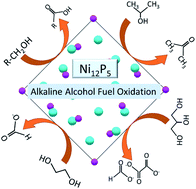Alcohol oxidation with high efficiency and selectivity by nickel phosphide phases†
Abstract
Small aliphatic alcohols are excellent fuels that have a much higher energy density than liquid H2. It is advantageous to avoid their complete oxidation to CO2 and produce chemicals with higher commercial value along with moderate energy extraction. We explored three different phases of nickel phosphide (Ni12P5, Ni2P, and Ni5P4) for the electro-oxidation of methanol, ethanol, isopropanol, ethylene glycol, and glycerol. Ni12P5 exhibits excellent activity (210 mA cm−2 at 1.72 V vs. RHE), durability, and mass activity (∼4.2 A mg−1), outperforming the state-of-the-art catalysts. We compared the reaction mechanisms and concluded that except ethylene glycol, the various alcohols are oxidized following a similar reaction mechanism, both on Ni12P5 and on Ni2P. The high selectivity of the reaction and the large suppression of further oxidation to CO2 are a marker of a preferred bidentate adsorption configuration that conveys a specific O–H activation reaction path. The catalysts show excellent activity towards alcohol oxidation and durability, likely thanks to the mild conditions required for the process, which allow the formation of a regenerating thin active layer of oxidized nickel.



 Please wait while we load your content...
Please wait while we load your content...